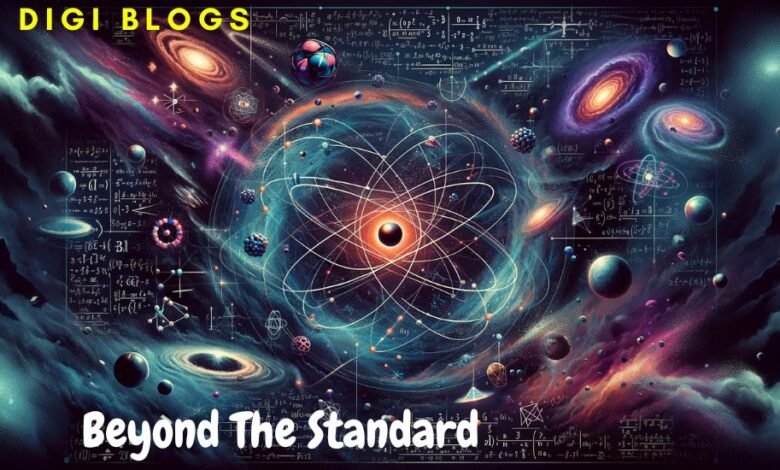Beyond The Standard: Unveiling The Universe’s Deepest Secrets
Overview of Beyond the Standard

The quest for understanding the fabric of the universe has led physicists to develop the Standard Model, a theory that has remarkably explained the behavior of fundamental particles and forces. However, this model is not without its limitations. Beyond the Standard explores the theoretical frameworks and experimental evidence that seek to address these limitations, offering a glimpse into the profound mysteries of our universe that remain unsolved.
What Is Beyond the Standard?
Beyond the Standard refers to the array of theoretical physics endeavors aimed at extending or replacing the Standard Model of particle physics. The Standard Model, despite its precision and predictive power, falls short in explaining phenomena such as gravity, dark matter, dark energy, and matter-antimatter asymmetry in the universe. Theories and research in the “Beyond the Standard” domain strive to fill these gaps, pushing the boundaries of our understanding.
Benefits Of Beyond the Standard
Exploring Beyond the Standard is not merely an academic exercise but a journey that holds the potential to revolutionize our understanding of the universe. It could lead to the discovery of new fundamental particles, provide insights into the universe’s birth and evolution, and even uncover new forces of nature. Furthermore, advancements in this field could drive technological innovations, similar to how quantum mechanics paved the way for semiconductors and, consequently, modern electronics.
The History of Beyond the Standard
The history of Beyond the Standard is intertwined with the development of the Standard Model itself. As early as the 1970s, physicists recognized the model’s limitations, particularly its inability to incorporate gravity. This realization sparked efforts to go beyond, leading to the development of theories such as supersymmetry, string theory, and loop quantum gravity, each proposing unique solutions to the unresolved puzzles.
The Future of Beyond the Standard
The future of “Beyond the Standard” is incredibly promising, with ongoing experiments and theoretical research poised to unlock new aspects of particle physics. Projects like the Large Hadron Collider (LHC) and observatories studying cosmic phenomena continue to provide valuable data that challenge and refine our theories. The discovery horizon is vast, and the next breakthrough could fundamentally alter our understanding of the cosmos.
How Does Beyond the Standard Work?
Beyond the Standard operates through a combination of theoretical predictions and experimental verification. Theoretical physicists propose models that extend the Standard Model, predicting new particles, forces, or phenomena. These predictions then guide experimental physicists in designing experiments and observations to confirm or refute the theories. This iterative process between theory and experiment is central to advancing our understanding of the universe.
Challenges and Controversies in Beyond the Standard
Exploring “Beyond the Standard” involves navigating through complex theoretical landscapes and confronting the limits of current experimental technologies. Theoretical models like string theory and loop quantum gravity offer compelling visions of the universe but face criticism for the lack of direct experimental evidence. As such, one of the significant challenges in this field is developing experiments sensitive enough to test these theories.
Collaborative Efforts and Interdisciplinary Approaches
The pursuit of understanding “Beyond the Standard” is inherently interdisciplinary, requiring collaboration across various fields of physics, mathematics, and engineering. Projects like the LHC exemplify how collaborative efforts can lead to significant advancements. Moreover, advancements in computational technologies and data analysis are playing a crucial role in processing and interpreting the vast amounts of data generated by experiments, highlighting the importance of interdisciplinary approaches in this quest.
Final Thoughts
Beyond the Standard represents the cutting edge of our quest to understand the universe. While the journey is challenging, it promises to unveil the deepest secrets of the cosmos, offering insights into the fundamental nature of reality. As we continue to push the boundaries of what is known, “Beyond the Standard” remains a beacon of scientific exploration and discovery.
FAQs on Beyond the Standard
What is the Standard Model unable to explain?
The Standard Model cannot adequately explain gravity, the existence and nature of dark matter and dark energy, neutrino oscillations, and the asymmetry between matter and antimatter. These phenomena represent some of the universe’s most profound mysteries, driving the search for new physics “Beyond the Standard.”
Why is it difficult to test theories Beyond the Standard?
Many theories “Beyond the Standard” predict phenomena that occur at energy scales or dimensions not yet accessible with current technology. The immense energies required to probe these theories, along with the need for extremely sensitive detectors to observe predicted rare or subtle effects, make experimental verification challenging.
How could discoveries Beyond the Standard impact our daily lives?
While the implications might not be immediately apparent, discoveries “Beyond the Standard” could lead to new technologies and materials, much like how quantum mechanics led to the development of semiconductors and lasers. Understanding the fundamental principles of the universe also has the potential to inform the development of new energy sources or novel forms of communication.
What would confirmation of Beyond the Standard theories mean for physics?
Confirmation of Beyond the Standard theories would revolutionize our understanding of the universe, potentially leading to new technologies and fundamentally changing our conception of the universe’s composition and the laws governing it. It would represent a monumental leap in our quest to understand the cosmos.





